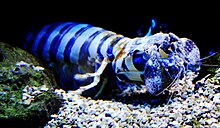| Mantis shrimp Temporal range:
| |
|---|---|

| |
| Odontodactylus scyllarus (Red Mantis Shrimp) | |

| |
| Lysiosquillina maculata (Zebra Mantis Shrimp) | |
| Scientific classification | |
| Domain: | Eukaryota |
| Kingdom: | Animalia |
| Phylum: | Arthropoda |
| Class: | Malacostraca |
| Subclass: | Hoplocarida |
| Order: | Stomatopoda Latreille, 1817 |
| Subdivisions[1] | |
|
Superfamilies and families Bathysquilloidea
Erythrosquilloidea Squilloidea Eurysquilloidea Parasquilloidea | |
Mantis shrimp are carnivorous marine crustaceans of the order Stomatopoda (from Ancient Greek στόμα (stóma) 'mouth' and ποδός (podós) 'foot'). Stomatopods branched off from other members of the class Malacostraca around 400 million years ago.[2] Mantis shrimp typically grow to around 10 cm (3.9 in) in length, while a few can reach up to 38 cm (15 in).[3] A mantis shrimp's carapace covers only the rear part of the head and the first four segments of the thorax. Varieties range in colour from shades of brown to vivid colours, with more than 520 species of mantis shrimp known. They are among the most important predators in many shallow, tropical and subtropical marine habitats. However, despite being common, they are poorly understood, as many species spend most of their lives sheltering in burrows and holes.[4]
Called "sea locusts" by ancient Assyrians, "prawn killers" in Australia,[5] and now sometimes referred to as "thumb splitters" due to their ability to inflict painful wounds if handled incautiously,[6] mantis shrimp have powerful raptorial appendages that are used to attack and kill prey either by spearing, stunning, or dismembering. Some mantis shrimp species have specialised calcified 'clubs' that can strike with great power, while others have sharp forelimbs used to seize the prey (hence the term "mantis" in their common name).
- ^ Joel W. Martin & George E. Davis (2001). An Updated Classification of the Recent Crustacea (PDF). Natural History Museum of Los Angeles County. p. 132. Archived from the original (PDF) on 2013-05-12. Retrieved 2009-12-14.
- ^ Van Der Wal, Cara; Ahyong, Shane T.; Ho, Simon Y. W.; Lo, Nathan (21 September 2017). "The evolutionary history of Stomatopoda (Crustacea: Malacostraca) inferred from molecular data". PeerJ. 5: e3844. doi:10.7717/peerj.3844. PMC 5610894. PMID 28948111.
- ^ James Gonser (February 15, 2003). "Large shrimp thriving in Ala Wai Canal muck". The Honolulu Advertiser. Archived from the original on November 11, 2020. Retrieved July 20, 2006.
- ^ Ross Piper (2007). Extraordinary Animals: An Encyclopedia of Curious and Unusual Animals. Greenwood Press. ISBN 978-0-313-33922-6.
- ^ "Mantis shrimp". Queensland Museum. Archived from the original on January 21, 2021.
- ^ Gilbert L. Voss (2002). "Order Stomatopoda: Mantis shrimp or thumb splitters". Seashore Life of Florida and the Caribbean. Dover pictorial archive series. Courier Dover Publications. pp. 120–122. ISBN 978-0-486-42068-4.